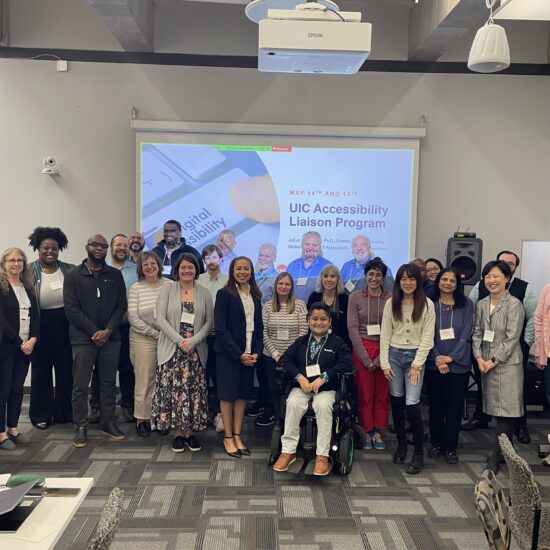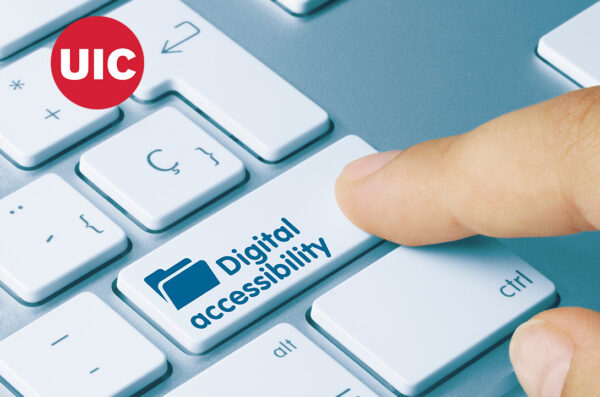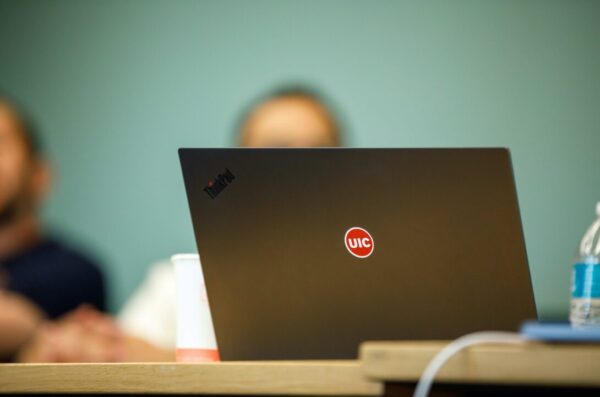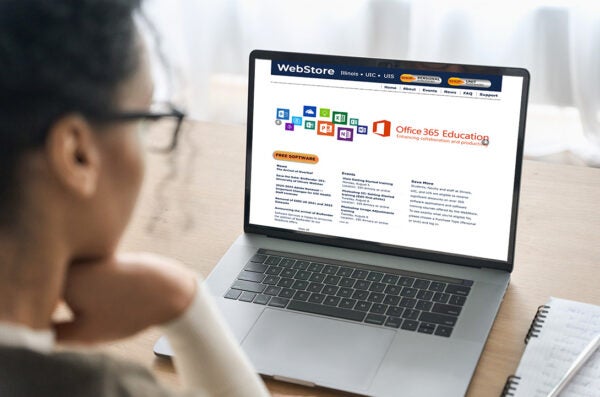Welcome to the Digital Accessibility (DA) Resource Hub
Welcome to the Digital Accessibility (DA) resource hub, your go-to destination for all things related to digital accessibility at UIC. We are committed to making our digital content, platforms, and tools accessible to everyone, including people with disabilities. This supports our values of inclusivity and equality. This page provides comprehensive information, policies, and training resources to help instructors and staff create and maintain accessible digital environments.
As one of the most ethnically and culturally diverse universities in the country, UIC recognizes that our community has a diverse range of hearing, movement, sight and cognitive abilities. We are committed to ensuring that our IT resources, such as websites, web applications, teaching and learning technologies, digital content and other electronic platforms and related communications can be used by all members of our community and are compliant with the Americans with Disabilities Act (ADA).
I need to request an:
Digital Accessibility at UIC

Need support? Contact your Accessibility Liaison
Discover who your Accessibility Liaisons are for your college and department. If you encounter any accessibility issues or have suggestions on how we can improve accessibility, please reach out to our Accessibility Liaisons.
Frequently Asked Questions
Find answers to Frequently Asked Questions related to Digital Accessibility and upcoming Title II ADA changes.
Why are we updating our digital accessibility practices?
The U.S. Department of Justice recently made changes to title II of the Americans with Disabilities Act (link opens in new window), the requirement for governmental entities to comply with the ADA. These updates dictate specific standards and a timeline for compliance for our obligation to make all digital content, including, but not limited to, online course content and mobile applications. In sum, these changes mean that all digital content must be readily usable by and accessible to individuals with disabilities.
UIC’s commitment to accessibility goes beyond one of legal compliance. As one of the most ethnically and culturally diverse universities in the country, UIC also recognizes that a diverse range of hearing, movement, sight, and cognitive abilities enriches and strengthens our academic community. We now have an opportunity to set the standard for inclusive digital practices.
What does “digital accessibility” mean, and why is it important?
Digital accessibility refers to the design and development of digital content, technologies, and environments (like websites, apps, and documents) so that people with disabilities can perceive, understand, navigate, and interact with them effectively, just like anyone else.
Why It’s Important:
- Equal Access and Inclusion: Over 1 billion people globally live with some form of disability; in addition, 21% of college students reported having a disability in 2024. Digital accessibility ensures that everyone, regardless of ability, has equal access to information and services.
- Legal Compliance: ADA Title II requires state universities to reach accessibility compliance by April 2026. Read more about Title II.
- Better User Experience for All: Features like keyboard navigation, captions, or voice commands benefit not just those with disabilities but also users in different contexts (e.g., watching a video in a noisy environment).
Expands Audience Reach: Accessible digital platforms are usable by more people, including aging populations, which increases engagement and potential student reach.
What’s the timeline for making content accessible?
The university has until April 2026 to reach compliance, according to the timeline set forth by the DOJ.
Is Digital Accessibility an Accommodation?
No, Digital Accessibility is not considered an accommodation in the traditional sense—it’s more accurately understood as a baseline requirement or design principle.
- Accessibility means designing digital content, tools, and platforms (like websites, apps, documents, etc.) so that people with disabilities can use them without needing special modifications. It’s proactive and built-in from the start.
- Accommodation, on the other hand, refers to individualized adjustments made when accessibility hasn’t been fully achieved. For example, if a website isn’t accessible to screen readers, an accommodation might be providing an alternative format of the content upon request.
For a physical analog, imagine our classroom spaces on campus – with a small number of exceptions, the campus community can assume that all classrooms are fully physically accessible to those with disabilities, because of proactive design elements such as elevators, ramps, and door activators. Should a student or employee require accommodations to remove barriers to access (such as priority registration or use of specific furniture), the Disability Resource Center and Office for Access and Equity are available to support such accommodation requests on an individual basis.
How does this impact instructors and course content?
Instructors must ensure that all course materials are accessible. This includes lecture slides, reading materials, videos, and assignments. Captioning videos, providing transcripts, and using accessible document formats are key components of compliance.
Will this impact the use of third-party tools and content?
Yes. Third-party tools, apps, or content (such as videos, software, or websites) will need to be fully accessible if these materials are used for courses, programs, and activities. Read about Title II exceptions regarding third party tools here.
None of my students submitted an accommodation request. Do I still need to make my course accessible?
Yes. Updates to ADA Title II requires governmental entities to make their digital content accessible. Remember: Access to accessible digital content is not an accommodation provided by UIC Disability Resource Center. Read more about Title II accommodations here.
Is it sufficient to create an accessible alternative version of a document for those who need them?
No. The primary content must be accessible unless prevented by technical or legal constraints outside of the university’s control.
Whom should I contact to get support with making my course materials accessible?
There are several resources available to support accessibility efforts:
Instructional Design Team (College-level):
Provides guidance on accessible course design, including structure, content formatting, and use of instructional technologies.
Learning Management System (LMS) Support Team:
Assists with accessibility evaluation and remediation, particularly if your course materials are stored within the LMS during a platform migration or update.
Digital Accessibility Services and Engineering Team (Technology Solutions):
Offers technical support and general accessibility checker tools for ensuring digital content and platforms meet accessibility standards, including WCAG compliance.
How does this affect content created by students?
Students must ensure that any digital content they create for university business is accessible. This might include work done in a university-affiliated job or internship. However, students are not required to make academic coursework or personal content accessible.
What does this have to do with the move to Canvas?
Technology Solutions is currently looking at accessibility support in Canvas and will post a report on this website when it’s ready.
Who is responsible for ensuring digital accessibility?
All university staff, faculty, and instructors who produce or manage digital content are responsible for ensuring its accessibility.
What types of content need to be accessible?
Any digital content that the university creates, publishes, or shares broadly must be accessible. This includes:
- Webpages
- PDFs, PowerPoints, and other documents.
- Online course materials.
- Videos
- Images (with alt text).
- Apps and software platforms.
- Mass email communications.
- Social media content.
Do I need to make all my past digital content accessible, or just new content moving forward?
All digital content that is used to apply for, gain access to, or participate in services, programs, and activities of the university must be accessible. There are exceptions for content that falls outside of this use, such as archived content; however, such content would need to be made accessible upon request. Social media content posted prior to June 24, 2024, does not need to be made accessible.
How much time will it take me to make my materials accessible?
Creating accessible materials from scratch only takes a little extra time once you know the basics. Remediating existing content varies — simple updates, like adding alt text or formatting a syllabus, might take just a few minutes, while more complex adjustments may take longer. The key is knowing the basics; with practice, accessibility becomes a natural part of your workflow. Digital Accessibility Services and Engineering (Technology Solutions) provides various training and consultation services read more about their offerings here.
Is access to accessible content an accommodation?
No, access to accessible media is not an accommodation. Accessible design supports the right to information for all, while accommodations address specific needs around how someone uses technology. Accessible media ensures that everyone, including individuals with disabilities, can independently access information and resources without needing to request special arrangements. This is different from accommodations, which adjust how individuals interact with technology or environments, such as extended test times or providing assistive devices.
How can I check the accessibility of my digital assets and remediate issues?
To make your digital content accessible, use built-in tools like Microsoft Word’s and PowerPoint’s Accessibility Checker or Adobe Acrobat’s Full Check to identify and fix common issues such as missing alt text and reading order. For web content, browser extensions such as WAVE and axe DevTools can flag structural and navigational issues, while WebAIM’s Contrast Checker ensures the color contrast meets the WCAG standards.
How will the university support me in making content accessible?
UIC will be putting resources in place and offering skill-building opportunities to allow instructors and staff to feel comfortable creating accessible materials, recognizing inaccessible materials, and performing basic accessibility remediation.
Where can I find resources and tools for accessibility?
This digital accessibility website houses resources such as training materials, guidelines, and accessibility checklists. UIC Digital Accessibility Services and Engineering (DASE) team also provides monthly accessibility webinars and weekly digital accessibility office hours. Upcoming events will be posted at the bottom of this page.
What training is available for faculty and staff?
We will offer regular workshops and training sessions on digital accessibility best practices, including creating accessible course materials, documents, and web content. Self-paced online training and resources will also be available. Upcoming workshops and training sessions will be posted at the bottom of this page.
How can I check if the software I use is accessible?
If the software is licensed through a third party, you can contact the vendor and ask them to provide a VPAT (Voluntary Product Accessibility Template). A VPAT is a document used by Information Technology (IT) vendors to describe how their products and services conform to accessibility standards.
In addition, you can log a ticket with Technology Solutions in TDX by emailing ithelp@uic.edu. One of our specialists will conduct an audit and provide a report. If you do acquire a VPAT, please add it to your ticket, and we will check it against the software.


